- Submissions

Full Text
Environmental Analysis & Ecology Studies
An Ecological Analysis of Forest Accounting
Parashram Jakappa Patil*
Symbiosis International (Deemed University), India
*Corresponding author: Parashram Jakappa Patil, Symbiosis International (Deemed University), India
Submission: February 15, 2018;Published: August 31, 2018

ISSN 2578-0336 Volume4 Issue2
Abstract
It is necessary to make theoretical analysis of various ecological aspects of forest accounting to make further improvement in it. World needs immediate action at theoretical and applied level as far as biodiversity is concerned. Forest accounting to certain extent help to mitigate same problem. The main objective of the study is to make ecological analysis of forest accounting in physical and monetary terms. The specific objectives of the study are as follows [1]. To study various ecological parameters of forest accounting [2]. To study significance of ecological features in forest accounting. Present study concludes that the ecological aspects of forests is vital for proper forest accounting system. And absence of forest accounting made impact on biodiversity and economy.
Keywords: Forest accounting; Forest valuation; Ecology; Biodiversity; Economics
An Ecological Analysis of Forest Accounting
Introduction
Forests maintain the ecological balance & life-support systems which is essential for food production, health as well as overall development of human kind. Forests services are invisible have been not accounted because of its resources values are neglected. It is leading big biodiversity loss that may cause to risk of disaster.
Statement of the problem
Global concern about forest degradation and depletion is related to two main problems i.e. destruction of the carbon sinks affecting the global climate and extinction of species affecting the biodiversity. Therefore, it needs immediate action at theoretical and applied level. Forest accounting to certain extent help to mitigate same problem. Forest accounting has various dimension and one of the important dimensions is its ecological classification. Forest accounting is complex phenomena involving invisible services of ecosystem and conversion of it in economic terms.
Review of literature
It has been examined earlier studies on forest accounting to explore various aspects of it. It supports to understand inter linkages between various factors while making theoretical analysis of ecological forest accounting. Haripriya et al. [3] they pointed out that to set out and apply a SEEA based methodology to show the true value of forest resources in India’s national as well as state accounts. It is focused on four components of value creation in forest i.e. timber production, carbon storage, fuel wood usage and the harvesting of non-timber forest products. Harries M et al. [4] they critically examine the natural resource accounting in theory and practices. The prime aim of the study is an extensive review of the theoretical and applied literature on natural resource accounting. They also study the explaining of the economic theory that underpins natural resource accounting, counseling welfare and sustainability of the policy goals. In the study they present various concept of national income. Parikh [5] pointed out that the natural resource accounting for soil to estimate costs of soil degradation for India. Blignaut & Hassan [1] have studied natural resource accounting of mineral resources i.e. gold and coal in South Africa.
Objectives of the Study
The main objective of the study is to make ecological analysis of forest accounting in physical and monetary terms. The specific objectives of the study are as follows:
A. To study various ecological parameters of forest accounting.
B. To study significance of ecological features in forest accounting [6].
Preposition
Ecological features make impact on forests monetary value [7].
Plant organic carbon pool
Research Methodology
The present research is case study of one of the forest rich district in India i.e. Kolhapur district forest. This district is situated in Western Ghats which is one of the mega biodiversity hubs in the world. Its theoretical analysis of various ecological components of forest accounting. Present study is mainly depending of secondary sources of data [8].
Data Collection
Primary data
Present study is not based on primary data hence it does not require to collect it.
Secondary Data
Since present study is based on secondary sources of data it collects in various ways as follows:
A. Published Sources: The researcher collected the data from sources such as Directorate of Economics and Statistics (DES), Forest Department Government of Maharashtra, Administrative Report of Forest Department, Forest Survey of India, National Sample Survey of organization (NSSO), Central Statistical organization (CSO) and Books, research papers published in the Journals, Articles and different Websites etc.
B. Unpublished Sources: It includes unpublished research such as M. Phil dissertation, Ph.D. Thesis and reports.
C. Topical Scope of Study: Present research work is restricted only to forest accounting.
D. Analysis of the Study: Present research work made theoretical analysis of various ecological components of forest accounting [9].
Forest Accounting
It provides framework to capture to value of all economic contribution of forests and how they are linked to economy. There are certain parameters uses for the analyzing and keeping of forest resources accounting which are given below [10].
Actual/economic accounts
A. Physical Account
B. Monetary Account
C. Flow Account
Financial performance (income and expenditure) and ecological classifications
A. Legal Classification of Forests
B. Forest Types Wise
C. Species Wise
D. Animal/Fauna Wise
E. Forest Product Wise.
Valuation methods
A. Historical Cost Method
B. Market Price Method
C. Net Present Value Method
D. Discounted Cash Flow Method
E. Scholastic Discounted Cash Flow Method
F. Real Option Pricing Methods
G. Sensitivity Analysis
These parameters would help to make forest accounting to great extent in comprehensive manner. Apart from such parameters there are other parameters also that needs to be consider care such non-financial parameter. It is really challenging to make forest accounting since yet there is not comprehensive scientific forest accounting system have not been developed. Forest accounting is interdisciplinary field involving various discipline such as economics, finance, sociology, life sciences, mathematics, statistics, and physiology [11]. Therefore, this subject brings various challenges for researchers and policy makers at various stages.
Ecological Analysis of Forest Accounting
The value of forest is depending on its ecological characteristics and therefore while making forest accounting ecological classification is significant. The Ecological land classification is a cartographical delineation or regionalization of distinct ecological areas, identified by their geology, topography, soils, vegetation, climate conditions, living species, habitats, water resources, and sometimes also anthropic factors. However, Forest Ecology is the scientific study of the interrelated patterns, processes, flora. Fauna and ecosystems in forests. The management of forests is known as forestry, silviculture, and forest management. A forest ecosystem is a natural woodland unit consisting of all plants, animals and microorganisms (Biotic components) in that area functioning together with all the non-living physical (abiotic) factors of the environment. The forest ecosystem is very important. Following is the forests ecological classification of Kolhapur district [12].
Trees
It has been in existence for 370 million years. In botany, a tree is a perennial plant with an elongated stem, or trunk, supporting branches and leaves in most species. In some usages, the definition of a tree may be narrower, including only woody plants with secondary growth, plants that are usable as lumber or plants above a specified height. Trees are not a taxonomic group but include a variety of plant species that have independently evolved a woody trunk and branches to tower above other plants to compete for sunlight. In looser senses, the taller palms, the tree ferns, bananas and bamboos are also trees. Trees tend to be long-lived, some reaching several thousand years old [13-16].
Source: Forest Department of Kolhapur District. The Table 1 shows that the Kolhapur district is reach by diversified trees at large number. There are various kind of trees are available in forests of Kolhapur district. It increases prospects of forests. Therefore, it is important to protect them. Species of trees are influence forest monetary value that become basis for forest accounting [17-20].
Table 1:Trees in Kolhapur district.

Shrubs: A shrub is an important component of forests. It is a small to medium-sized woody plant. It is distinguished from a tree by its multiple stems and short height. Plants of many species may grow either into shrubs or trees, depending on their growing conditions [21].
Source: Forest Department of Kolhapur District. The Table 2 shows that there are various species of shrubs are available in Kolhapur district forest. It is providing very valuable input to society. These all shrubs have its contribution in forest economy. There is need to take that monetary contribution in forest accounting of district [22].
Table 2:Shrubs in Kolhapur district.
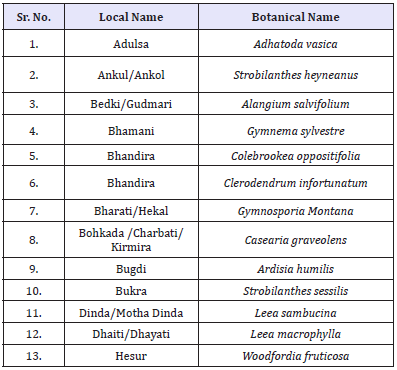
Climbers: The climbing plant is vital in forest ecology. The Climbing plants are plants which climb up trees and other tall objects. Many of them are vines whose stems twine round trees and branches. There are quite several other methods of climbing [23].
Source: Forest Department of Kolhapur District. Table 3 shows that there are no of climbing plants available in Kolhapur district. Along with environmental there are commercial importance of such plants such as use in gardening and horticulture. It’s a value addition in forest economics of district.
Table 3:Climbers in Kolhapur district
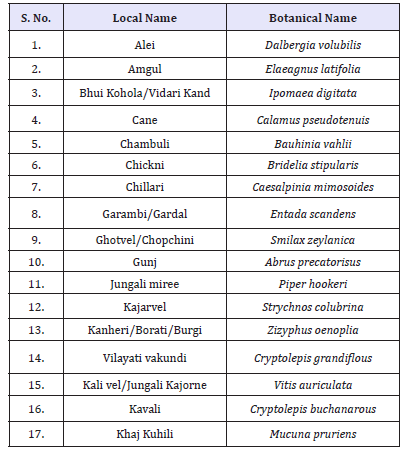
Bamboos
The Bamboos are the significant crop of agro forestry economy. It has notable economic and cultural significance in society being used for building material, as a food source, and as a versatile raw product. It has a higher specific compressive strength than wood, brick, or concrete and a specific tensile strength that rivals steel [24-26].
Source: Forest Department of Kolhapur District. Table 4 indicates that there are total 4 kinds of Bamboos species available in forest of Kolhapur district. The Bamboos has important commercial uses such as culinary, medicine, constructions, weapons, food, textiles, and musical instruments etc. The commercial value of such inputs enriches the forest accounting at large extent.
Table 4:Bamboos in Kolhapur district.

Grasses
It means a low, green plant that grows naturally over a lot of the earth’s surface having groups of very thin leaves that grow close together in large numbers (Oxford dictionary). It is a very common plant consisting of large number of thin, spiky, green leaves that cover the surface of the ground [27].
Source: Forest Department of Kolhapur District. Table 5 shows that there are total 24 different species of grass available in district. It is very helpful to mankind, agriculturally, economically and ecologically. It is important source of food for man and animals both. Thus, its contribution needs to measure in monetary value and include in forest accounting.
Table 5:Grasses in Kolhapur district.
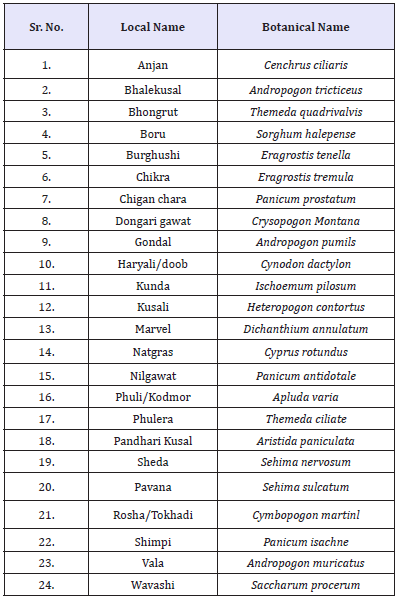
Medical Plants
The medical plants have been identified and used through in human history. It’s part of culture and tradition since centuries. Plants make many chemical compounds that are for biological functions including defense against insects, fungi and herbivorous mammals. The medical plants have huge commercial benefits, it generates business out of it. Kolhapur district has numerous medical plants in its forests as follows.
Abrus precatorius, Abutilon indicum, Acacia concinna, Achyranthes aspera var, aspera, Acorus calamus, Adansonia digitata, Aegle marmelos, Alangium salvifolium var, salvifolium, Alsaonia schloaris, Anacardium occidentale, Andrographis paniculata, Anogeissus latifolia, Artocarpus, heterophyllus, Asparagus racemosus var, javanica, Azadirachta indica, Bacopa monnieri, Balanites aegyptiaca, Baliospermum montanu, Biophytum sensitivum, Bixa Orellana, Boerhavia repens var diffusa, Bombax ceiba, Bombyx micranthus, Boswellia serrate, Bridelia retusa, Buchanania cochinchinensis, Butea monosperma, Caesalpinia bonduc, Calotropis gigantean, C. procera, Careya arborea, Cassia fistula, C, obtusifolia, C. tota, Catharanathus roseus, Celastrus paniculatus, Celosia argentea var, argentea, Centella asiatica, Colocasia esculenta, Convolvulus arveensis, Cordia dichotoma, C. gharaf, Costus speciosus, Crateva adansonii subsp, odora, Crossandra infudibuliformis, Cullen corylifolia, Cuminum cyminum, Curculigo orchioides, Cymbopogon citratus, Cynodon dacthylon, Cyperus rotundus, subsp. Rotundus, Dendrophthoe falcate var, falcate, Dillenia indiaca, Dioscorea alata, D. bulbifera, Dodonea angustifolia, Dolichandrone falcate, Eclipata prostrate, Elaaeagnus conferta, Embelia ribes, Emblica officinalis, Entada rheedei, Ficus amottiana, F. benghalensis, F. callosa, F. carica, F. racemosa, F. religiosa, Garcinia indiaca, Garuga pinnata, Gloriosa superba, Glossocardia bosvallea, Gmelina arborea, Gnidia glauca, Hedyotis herbacea, Helicteres isora, Heliotropium indicum, and others
The identification and commercial valuation of medical plants provide the basis for forest accounting. The medical plants are major component of forest economy. Its increase the monetary value of entire forest. Infact, there are certain forests are kept only for medical plants. Therefore, collecting information of medical plants, analyzing it, interpreting it and recording it in monetary value is significant.
Mammals
The mammals include the largest animals on the planet, the great whales as well as some of the most intelligent such as elephants, primates and cetaceans.
Source: Forest Department of Kolhapur District. Table 6 shows that there are various species of mammals are available in district. It has direct contribution in human society and economy. For instance, domestic mammals form a large part of the livestock raised for meat across the world. It is commonly used in agriculture and allied activities. Forests is crucial component for existence of such mammals. The economic contribution of such mammals has linkages with forests.
Table 6:Mammals in Kolhapur district.

Avifauna
The birds or the kinds of birds of a region, period or environment. In simple word birds of a specific region or period. Birds are essential element of ecology.
Source: Forest Department of Kolhapur District. Table 7 indicates that there are bird’s species available in forest of Kolhapur district. Birds has providing very essential benefits to human being such as food, business, pollination, fertility, pest control, rodent control, communication, company, and games, etc. Therefore, economic contribution of birds is vital and existence of birds is depend on forests.
Table 7:Avifauna in Kolhapur district.

Crocodile
The Crocodiles (subfamily Crocodylinae) or true crocodiles are large aquatic reptiles that live throughout the tropics in Africa, Asia, the Americas and Australia.
Source: Forest Department of Kolhapur District. Table 8 shows that the crocodile is also found in forest of Kolhapur district. The Crocodiles play very important role in the river ecosystem to ensure that river. These invisible ecosystem services in monetary value needs to be taken into consideration.
Table 8:Crocodile in Kolhapur district.

Herpetofauna
The reptiles and amphibians of a particular region, habitat, or geological period. The Table 9 talks about Herepetoauna of Kolhur district.
Source: Forest Department of Kolhapur District. Table 9 reveals that there are different species available in forest of Kolhapur district. It is essential component of ecology and food chain. They provide numerous invisible services to protection of ecology.
Table 9:Herpetofauna in Kolhapur district.
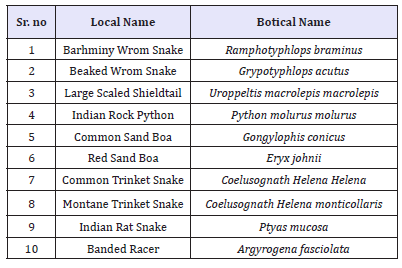
Turtle
The Turtles are classified as amniotes, along with other reptiles, birds, and mammals. Like other amniotes, turtles breathe air and do not lay eggs underwater, although many species live in or around water.
Source: Forest Department of Kolhapur District. Table 10 shows that there are total 6 species of turtle available in Kolhapur district forest. Turtles play an important role in the ecology and well-being of coastal and open ocean environments. It is essential for healthy ecosystem. It has biological, cultural and economic significance.
Table 10:Turtle in Kolhapur district.
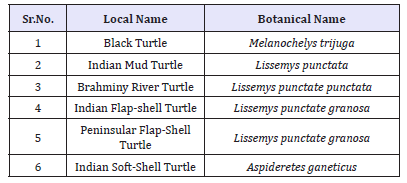
Gecko
The Geckos are lizards belonging to the infraorder Gekkota, found in warm climates throughout the world. Geckos are unique among lizards in their vocalizations. Table 11 shows that there are 4 species of Gecko available in Kolhapur district forest. Geckos are reptiles with unique and interesting features and play an important role in maintaining a balanced ecosystem.
Table 11:Gecko in Kolhapur district.
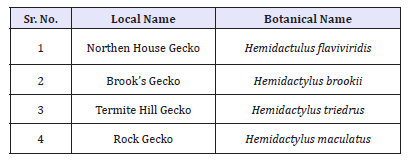
Agamids
The Agamidae is a family of over 300 species of iguanian lizards indigenous to Africa, Asia, Australia, and a few in Southern Europe. Many species are commonly called dragons or dragon lizards.
Source: Forest Department of Kolhapur District. Table 12 reveals that there are total 4 Agamids species found in Kolhapur forest. Agamids is important for ecosystem balance and its diversity.
Table 12:Agamids in Kolhapur district.

Chameleons
Chameleons or chamaeleons (family Chamaeleonidae) are a distinctive and highly specialized clade of old world lizards with 202 species described as of June 2015. These species come in a range of colors, and many species can change colors (Table 13).
Table 13:Chameleons in Kolhapur district.

Source: Forest Department of Kolhapur District. In Kolhapur forest chameleons is also found. Chameleons can vary their coloration and pattern through combinations of pink, blue, red, orange, green, black, brown, light blue, yellow, turquoise, and purple. It is important features of nature’s diversity.
Skinks
Skinks are lizards belonging to the family Scincidae and the infraorder scincomorppha. With more than 1,500 described species. The Scincidae is one of the most diverse families of lizards.
Source: Forest Department of Kolhapur District. Table 14 shows that their skinks species also available in Kolhapur forest. Various species occur in ecosystems ranging from deserts and mountains to grasslands.
Table 14:Skinks in Kolhapur district.

Monitor Lizard
Table 15:Monitor Lizard in Kolhapur district

Monitor lizard is the common name of several large lizard species, comprising the genus Varanus (Table 15).
Source: Forest Department of Kolhapur District. Monitor lizards is useful. It is used for a variety of medical purposes. The flesh is eaten for the relief of rheumatic pain, abdominal fat is used as a salve for skin infections, oil and fat are used to treat hemorrhoids or chronic pain, and the oil is used as an aphrodisiac lubricant.
Toads
It is a common name applied to certain frogs, especially of the family Bufonidae that are characterized by dry, leathery skin, short legs, and parotid glands (Table 16).
Table 16:Toads in Kolhapur district.

Source: Forest Department of Kolhapur District. Toads are important to the ecology and to humans. Toads provide important values for ecosystems and for human beings ecologically, they are important in food chains. Toads also serve as indicators of environmental health.
Frogs
A frog is any member of a diverse and largely carnivorous group of short-bodied, tailless amphibians composing the order Anura.
Source: Forest Department of Kolhapur District. Table 17 shows that there are total 10 species of Frogs available in Kolhapur district. The frogs provide essential benefit to human being such as medical advances, food, filter drinking water etc.
Table 17:Frogs in Kolhapur district.
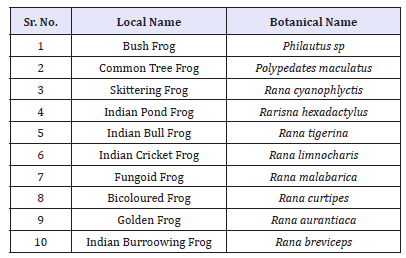
Butterflies
The butterfly is one of the most emblematic totem animals symbolizing personal transformation. Table 18 talks about different butterfly’s species in Kolhapur forest.
Source: Forest Department of Kolhapur District. Table 18 reveals that there are total 75 various species of butterflies available in Kolhapur forest. Butterflies are indicators of a healthy environment and healthy ecosystems. Butterflies are an important element of the food chain and are prey for birds, bats and other insectivorous animals.
Table 18:Butterflies in Kolhapur district.

Moths
Moths comprise a group of insects related to butterflies, belonging to the order lepidopeera. Most lepidopterans are moths; and there are thought to be approximately 160,000 species of moth, many of which are yet to be described. Most species of moth are nocturnal but there are also crepuscular and diurnal species. Table 19 belongs to Moths of Kolhapur forest.
Source: Forest Department of Kolhapur District. Table 19 shows that 19 Kolhapur forest has 6 various species of moths. It is major part of our biodiversity and play vital roles in the ecosystem, affecting many other types of wildlife.
Table 19:Moths in Kolhapur district.
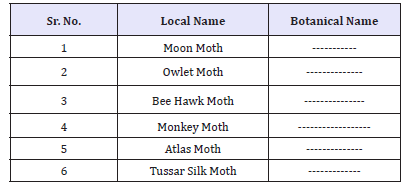
Insects
Insects are a class of invertebrates within the arthropodphylum that have a chitinous exoskeleton, a three-part body (head, thorax and abdomen), three pairs of jointed legs, compound eyes and one pair of antennae. Table 20 related to Insects in Kolhapur district.
Source: Forest Department of Kolhapur District. Table 20 shows that 13 species of insects are available in Kolhapur forest. Insects are very important as primary or secondary decomposers. Without insects to help break down and dispose of wastes, dead animals and plants would accumulate in our environment and it would be messy indeed. Insects are underappreciated for their role in the food web. Insects are important in nature to help keep pest populations (insects or weeds) at a tolerable level.
Table 20:Insects in Kolhapur district.
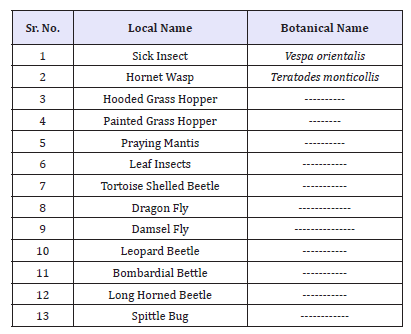
Arachnids
Arachnids are a class (Arachnida) of joint legged invertebrate animals (arthropods), in the subphylum Chelicerata. All arachnids have eight legs, although the front pair of legs in some species has converted to a sensory function, while in other species, different appendages can grow large enough to take on the appearance of extra pairs of legs. Table 21 belongs to Arachnids in Kolhapur district.
Table 21:Arachnids in Kolhapur district.
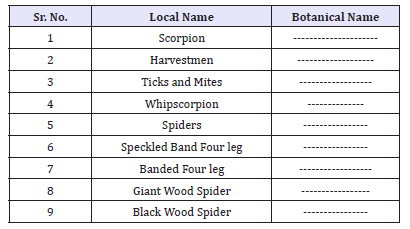
Source: Forest Department of Kolhapur District. Table 21 reveals that there are total 20 kind of species of Arachnids are available in Kolhapur forest. The arachnids play an important role in limiting the size of other arthropod populations, especially insects. Some arachnids are pests, such as ticks and mites, but most are beneficial and should be protected.
Conclusion
In forests valuation ecological features of forest is significantly influence forests monetary value. Hence it is inevitable that to make detailed ecological classification of forests. Kolhapur district forest has tremendous ecological inputs that increase value of forests. There are 20 ecological characteristics of Kolhapur forests such as Trees, Mammals, Arachnids, Insects, Moths, Butterflies, Frogs, Toads, Lizard, Skinks, Avifauna, Crocodile, Shrubs, Grasses, Bamboos, Medical plants, Climber, Herpetofauna, Agamids, Gecko, Turtle, Chameleons and its various species. These ecological elements enrich Kolhapur forests value in greater extent. Ecological diversified forests have more monetary value because it provides diversification in output of forests. Therefore, in making of forest accounting analysis of ecological elements of forest is essential. Being hilly region Kolhapur forests has scope for agro forestry practices such as cashew cultivation and mango cultivation. Agro forestry practices largely increases the prospects of Kolhapur forests. Forest accounting is helping to identified biodiversity loss and to mitigate risk of disaster.
References
- Blignaut JN, Hassan RM (2001) A natural resource accounting analysis of the contribution of mineral resources to sustainable development in South Africa. South Africa Journal of Economic and Management Sciences, Supplementary Series 3: 39.
- CGMA (2014) Rethinking the value chain. Accounting for Natural Capital in the Value Chain, World Congress of Accountant, London, pp. 1-16.
- Haripriya GS (2003) Integrating forest resource into the system of national accounts in Maharashtra, India. Environment and Development Economics 5(1): 143-156.
- Harries M, Fraser I (2002) Natural resource accounting in theory and practice: a critical assessment. The Australian Journal of Agricultural and Resource Economics 46(2): 139-192.
- Parikh K, Ghosh V (1995) Natural resource accounting form soils: towards an empirical estimation of cost of soil degradation for india, Indira Gandhi Institute of Development Research (IGIDR), Bombay, p. 22.
- Directorate of Economics and Statistics (DES), Planning Department, Govt. of Maharashtra, India
- Elmqvist T, Tuvendal M, Krishnaswamy J, Hylander K (2011) Managing of trade off in ecosystem services. The United Nations Environment Programme, Printing: Publishing Services Section, UNON, Nairobi- Kenya, pp. 1-17.
- Eliasch Review (2008) Climate change: Financing global forests, Earthscan Dunstan House 14a St Cross St London EC1N 8XA UK.
- Global Forest Resource Assessment (2010) Food and agriculture organization of the united nation (2011), FAO Forestry Paper, Rome, Italy 163: 12-13.
- India state of Forest Report (2011) Forest Survey of India (FSI)-2011, Ministry of Environment and Forests, India, pp. 4-5.
- INTOSAI Working Group on Environmental Auditing C/O The Netherlands Court of Audit (1998), Natural Resource Accounting.
- Jordon SJ, Hayes Sharon E, Yoskowitz D, Smith LM, Summers J, et al. (2010) Accounting for natural resources and environmental sustainability: linking ecosystem services to human well-being. Environ Sci Technol 44(5): 1530-1536.
- Kathuria Renu (2014) Natural Resource and Biodiversity Conservation, Shruti Publication, Jaipur-302005, India.
- Malhotra BN (2010) Management natural resources for sustainability livelihoods, Pearl Books, New Delhi-110002, pp. 210-277.
- Mabugu R, Chitiga M (2002) Accounting for forest resources in Zimbabwe, CEEPA-Discussion Paper Series, No-7, pp. 1-53.
- Manta William N, Chimtembo Mathew MB (2002) - Towards natural resource accounting in Tanzania: a study on the contribution of natural forests to national income, centre for environmental economics and policy in Africa (ceepa) discussion paper Series, No-2: 1-53.
- Naresh S, Bibhu N, Issues and challenges of integrating environmental accounts into system of national income accounting.
- Partha D (2009) The place of nature in economic development, university of Cambridge and University of Manchester London, UK.
- Patil RB (2009) Natural resources and sustainability of indian society. Shruti Publication, Jaipur -302005, India, pp. 228-345.
- Sarkar S (2008) Developing Green Accounting System, Serial Publication, New Delhi, India. pp. 13-15.
- Srivastava SC, Srivastava S, (2006) Economics of social sector and environment, Anmol Publications Pvt. Ltd., New Delhi, India - 110002.
- (2014) State of Forest Report -2013: Ministry of Environment and Forests, India.
- Statistic New Zealand (2002) Natural Resource Accounts for New Zealand: Overview Document, Christchurch, New Zealand.
- Shunsuke (2006) In their research paper entitled productivity and environment in India. Economics Bulletin 17(1): 1-14.
- Statistical Outline, Current Salient Forest Statistics-2013, Maharashtra Forest Department, Government of Maharashtra, India.
- Trivedi PR (2010) Natural resource conservation, A.P.H. Publishing Corporation, New Delhi-110002, India, pp. 1-30.
© 2018 Parashram Jakappa Patil. This is an open access article distributed under the terms of the Creative Commons Attribution License , which permits unrestricted use, distribution, and build upon your work non-commercially.
 a Creative Commons Attribution 4.0 International License. Based on a work at www.crimsonpublishers.com.
Best viewed in
a Creative Commons Attribution 4.0 International License. Based on a work at www.crimsonpublishers.com.
Best viewed in 







.jpg)






























 Editorial Board Registrations
Editorial Board Registrations Submit your Article
Submit your Article Refer a Friend
Refer a Friend Advertise With Us
Advertise With Us
.jpg)






.jpg)














.bmp)
.jpg)
.png)
.jpg)










.jpg)






.png)

.png)



.png)






